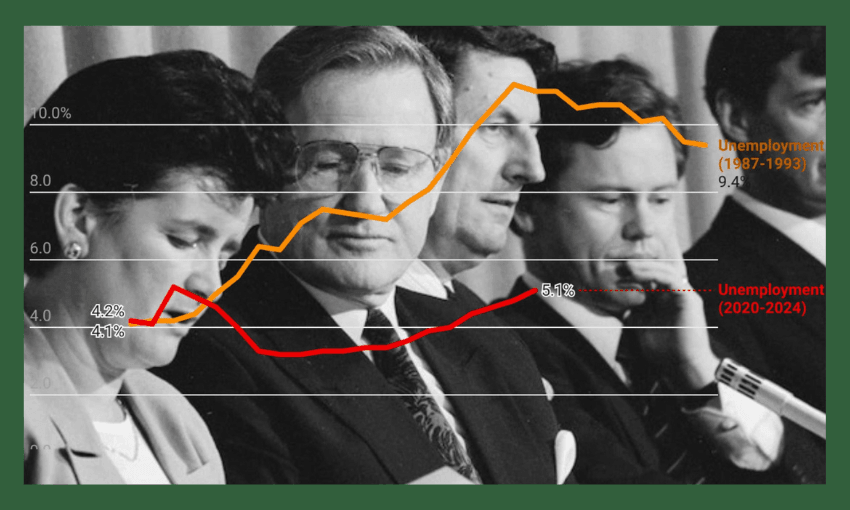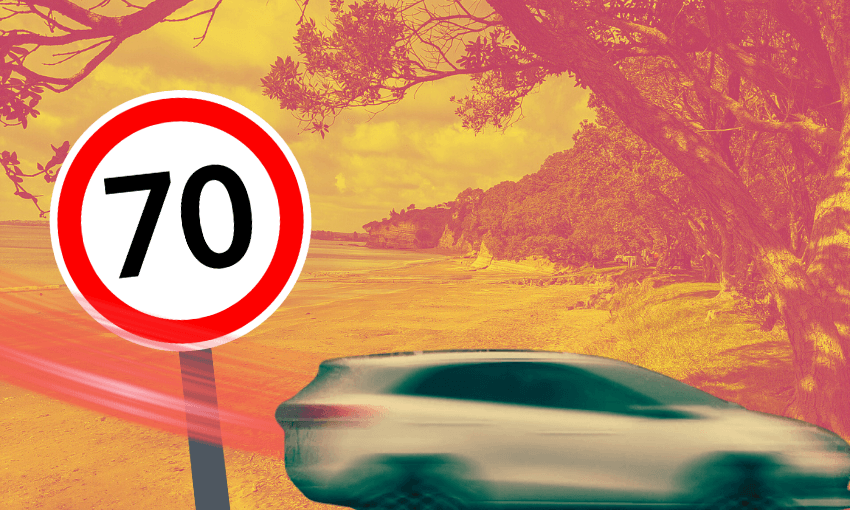The last time New Zealand had this kind of recession we voted in MMP. What might we do this time?
First published in Henry Cooke’s politics newsletter, Museum Street.
New Zealand is not at its best right now.
I write this from afar so I have to rely on brutal headline indicators and the testimony of my friends and family. Unemployment popped up above 5% in the final quarter of last year, with one in 10 Pacifica people out of a job and close to 100,000 young people not in education, training or work. High interest rates and falling house prices have made more secure people feel far poorer. Those able to are leaving the country in record numbers. All this is unsurprising as Aotearoa was in a serious recession last year – the worst six-month decline in GDP since 1991 (if you exclude the pandemic).
Wait a minute. 1991? Stop me if this sounds familiar:
- A Labour government faces a tough election year (1990) after two terms in office, opting to change its leader at the last minute but not getting anywhere near retaining power. Said leader stays on as few really think the loss is his fault or want the job right away.
- Interest rates are incredibly high to deal with a very serious inflation spike.
- Unemployment is high and the economy is going backwards.
- The incoming National government faces an immediate perceived need to cut government spending as Treasury forecasts widening deficits.
These are the broad outlines of both the 1990 election and the 2023 one, and if you look under the hood the comparisons never really end. “TV3” was in serious financial trouble in 1990, entering receivership at one point. Talk of a referendum on a four-year term was bouncing around. Petrol prices were high as turmoil roiled the Middle East. There was a big debate about cutting government spending on a single ship purchase.
Many familiar faces were there. Winston Peters was causing no end of mischief, consistently critiquing National in his last election fought under that party’s banner. Phil Goff was a leading young minister and key ally of the Labour right, while Helen Clark was threading a very different path towards the centre left. Don Brash was just getting started on his very long term as the governor of the Reserve Bank.
It’s not a perfect match. Things were a lot worse in the early 1990s.
Above is a look at unemployment, using the first quarter of 1987 and 2020 as our basis. As you can see we start at a similar point – but the 1990s recession hurt Kiwi workers a lot more. Interest rates were in the teens, not the single digits. The country’s books were in worse shape in general, giving Ruth Richardson (finance minister in the fourth National government from 1990-1993) far more ammo. Servicing government debt cost a whopping 6.3% of GDP in 1990, compared to 1.7% in 2023.
This led to cuts undertaken by Richardson that were on an entirely different level to those ever contemplated by Nicola Willis. Willis has effectively cut benefit rates in the future by indexing them to price inflation instead of wage inflation; Richardson just straight up slashed them. Willis has changed the parameters for fees-free university; Richardson allowed universities to set whatever fees they liked. Willis is looking to save money in health; Richardson looked to directly introduce a profit motive, with her government at one point suggesting a $50 fee for overnight hospital stays.
Richardson’s many cuts saw government spending shrink from 39.9% of the economy in 1991 to 37.1% in 1993 – which might not sound like a lot, but is quite a bit to manage in two years with spending of this magnitude. Willis is forecast to manage a trim from 33.6% in 2024 to 33.3% in 2026 – a cut of 0.3 percentage points compared to the 2.8 percentage points Richardson achieved. (Looking back at the historic data reveals some very interesting trends in where we spend our government money. In 1991 public health spending sat at 5.2% of GDP, education at 5.8%, and the wider benefits system at 12.8%. In 2024 health had grown to 7.3%, education shrunk to 4.9%, and the benefits system was down to 10.8%.)
And it wasn’t just spending – National also gutted unions with the Employment Contracts Act in the 1990-1993 term, a law change so sweeping that there is still a lively debate in union circles about whether or not they should have undertaken a general strike. Brooke van Velden is doing a lot to give more power to employers right now, but she has a lot less room to move than Richardson and her successor Bill Birch did, as key parts of the the Employment Contracts Act remain in place.
Richardson earned more of a backlash than Willis and Luxon have ever managed. At this point in the 1990-1993 cycle, Labour was about 10 points clear of National in the polls, as opposed to the single point they appear to be ahead by currently. Richardson required security help from the diplomatic protection squad. And yet National won in 1993.
The 1993 election is one of the most intriguing in modern New Zealand history. National won just 7,100 more votes than Labour, with neither party managing to get much more than a third of the vote, an amazing result in any election, but particularly one under the First Past the Post system that had largely locked out any other party from winning any seats. These two titans of postwar politics, which had both undertaken vigorous reform programmes while many voters looked on aghast, seemed utterly spent forces.
And best of all for voters who hated both of them, they had a way to show it – the MMP referendum held alongside the election. This referendum would create an entirely new world of coalitions and party votes and ways for voters to say not just that they didn’t like the government, but that they didn’t like the government in a specific way. Minor parties were already springing up everywhere, even before the system that would make their continued relevance possible, with Jim Anderton winning almost a fifth of the total vote for his left-wing Alliance and Peters making a strong showing in the first general election outing for NZ First.
As Helen Clark told me for my MMP series on Stuff, they “they wanted to put a ball and chain around politicians’ ankles". We are in very many ways still living in the world that those three years at the start of the 1990s created.
But what does this mean for the next election?
It’s very hard to tell. Under MMP, Labour’s 1993 results would probably have seen them lead the government. But as we have canvassed, there are major differences between our two eras, and it is very unclear if the backlash that National is currently facing will keep growing or peter out as interest rates drop and the economy (one hopes!) picks up. There is, if you are a National Party partisan, plenty of potential upside. National didn’t just scrape a win in 1993 – it actually managed to retain most of its vote in 1996, giving it the chance to lead government for another three years.
Outside of electoral politics, I wonder what might happen if we see discontent build to the level it did in the 1990s without the outlet of the MMP referendum and subsequent humiliation of the political class. A referendum on a four-year term gives one a far weaker avenue of telling the politicians you hate all of them. Where will that energy go instead?


